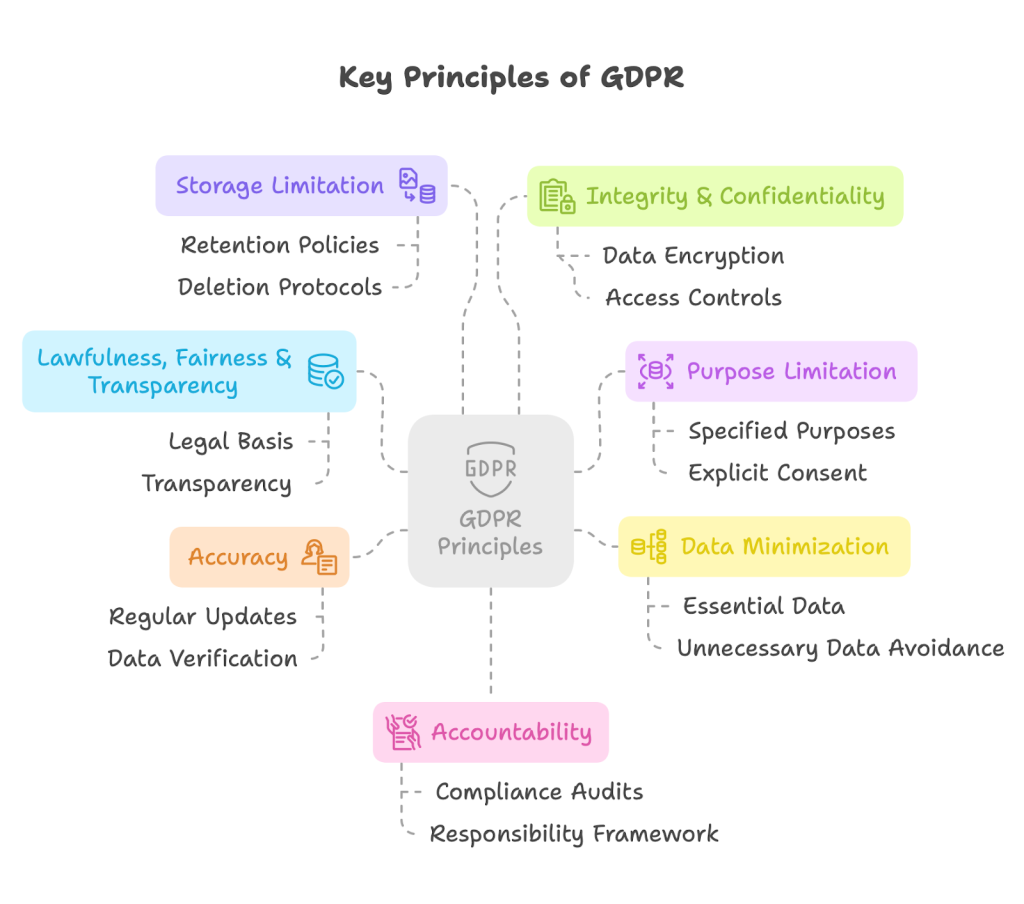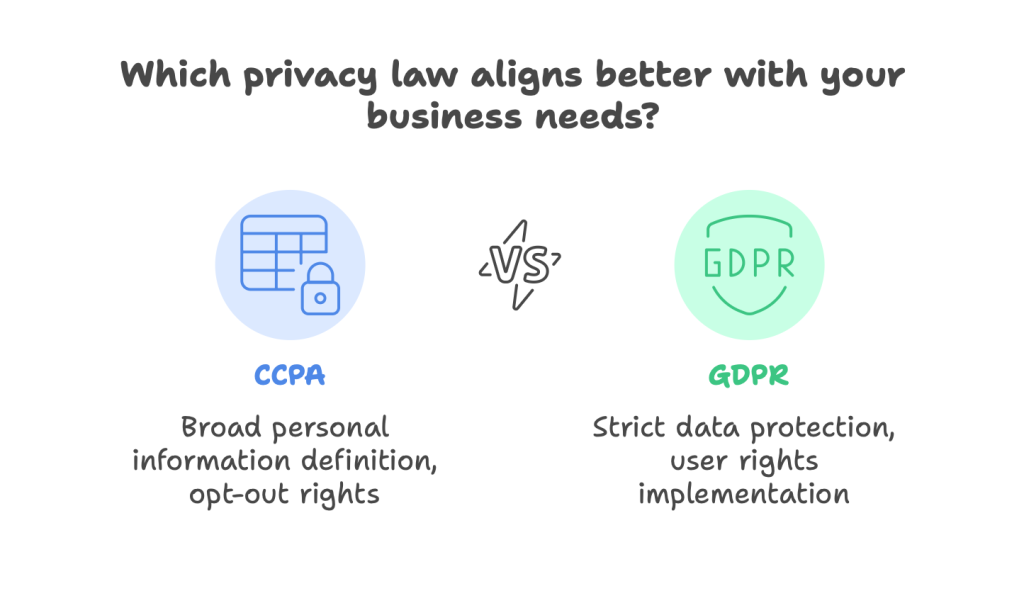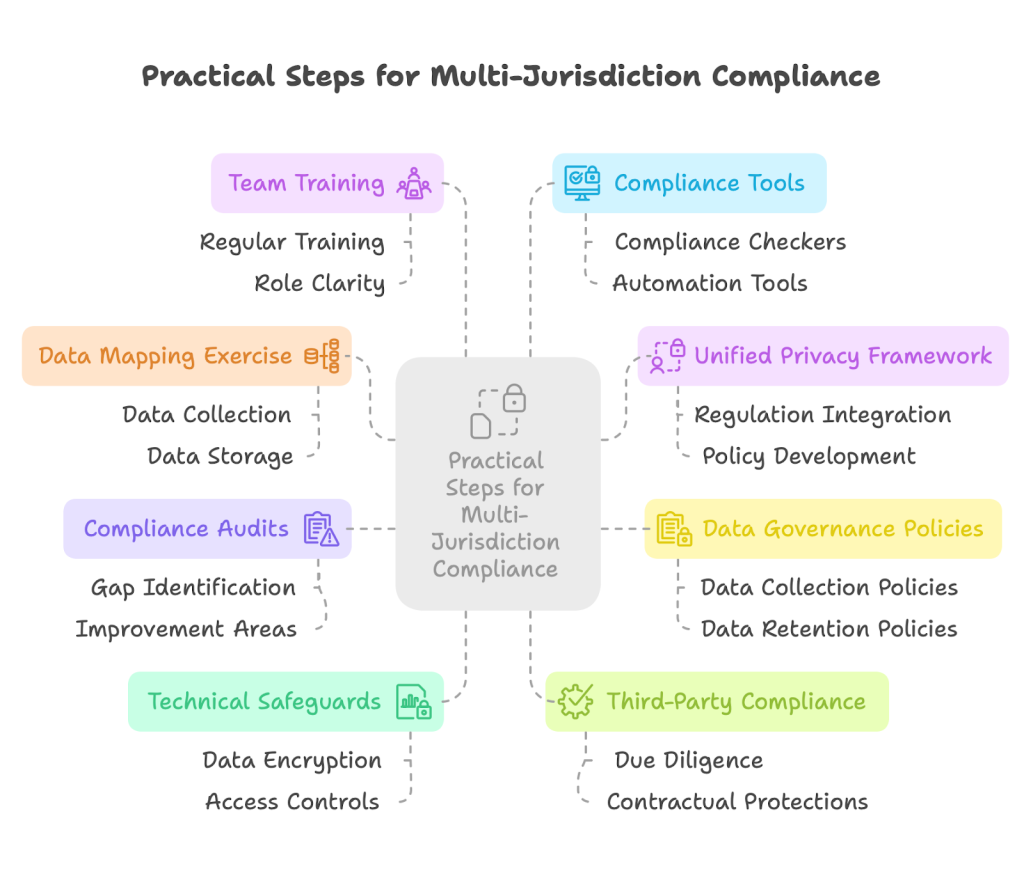Difference Between GDPR, CCPA & Other Data Privacy Laws: A Global Comparison
Compare global data privacy laws like GDPR, CCPA, LGPD, and PIPEDA to understand their unique requirements and ensure your website’s compliance across different jurisdictions.
In today’s digital economy, personal data has become one of the most valuable commodities. With increasing data breaches and privacy concerns, governments worldwide are implementing robust data protection laws to safeguard their citizens’ information. For businesses operating globally, navigating this complex landscape of regulations can be overwhelming.
Understanding the differences between major privacy laws such as the GDPR, CCPA, and others is crucial for ensuring compliance and avoiding hefty penalties. This comprehensive guide explores the key differences and similarities between these regulations and provides actionable insights for businesses to achieve compliance.
A Snapshot of Global Privacy Laws
The digital world has seen a significant shift in how personal data is protected, with various regions implementing their own frameworks to address privacy concerns.
GDPR (General Data Protection Regulation)
The General Data Protection Regulation, implemented in May 2018, stands as Europe’s robust framework for data protection. This comprehensive legislation applies to all organizations processing the personal data of EU residents, regardless of where the organization is based.

GDPR’s scope is expansive, covering virtually any information that can identify an individual, from names and email addresses to IP addresses and cookie identifiers. The regulation empowers EU citizens with significant rights over their data, including access, rectification, erasure, and portability.
For businesses, GDPR compliance means implementing strict data protection principles and facing potential fines of up to €20 million or 4% of global annual turnover for serious violations.
CCPA (California Consumer Privacy Act)
Effective since January 2020, the California Consumer Privacy Act represents America’s first comprehensive state-level privacy law. CCPA applies to businesses meeting specific thresholds: annual gross revenue exceeding $25 million, handling personal information of 50,000+ California consumers, or deriving 50% or more of annual revenue from selling California consumers’ personal information.
While CCPA provides Californians with rights similar to those under GDPR (access, deletion, and opting out of data sales), it defines personal information more broadly as anything that “identifies, relates to, describes, is capable of being associated with, or could reasonably be linked with a particular consumer or household.”
CPRA (California Privacy Rights Act)
Building upon CCPA, the California Privacy Rights Act (effective January 2023) expands consumer privacy rights in California. CPRA introduces the concept of “sensitive personal information” and establishes the California Privacy Protection Agency to enforce privacy regulations.
LGPD (Lei Geral de Proteção de Dados)
Brazil’s Lei Geral de Proteção de Dados, effective since September 2020, closely mirrors GDPR in many aspects. It applies to any business processing the personal data of individuals in Brazil, regardless of the company’s location.
LGPD grants Brazilian citizens similar rights to those under GDPR, including access, correction, anonymization, and data portability, with penalties of up to 2% of a company’s Brazilian revenue from the previous year.
PIPEDA (Personal Information Protection and Electronic Documents Act)
Canada’s Personal Information Protection and Electronic Documents Act governs how private sector organizations collect, use, and disclose personal information. While less stringent than GDPR, PIPEDA still requires informed consent for data collection and provides individuals with access and correction rights.
Other Notable Privacy Laws
- VCDPA (Virginia Consumer Data Protection Act): Effective January 2023, grants Virginia residents rights to access, correct, delete, and opt out of data processing for targeted advertising.
- CPA (Colorado Privacy Act): Coming into effect July 2023, applies to controllers processing personal data of 100,000+ Colorado residents or 25,000+ residents if deriving revenue from selling personal data.
- CTDPA (Connecticut Data Privacy Act): Effective July 2023, applies to businesses processing data of 100,000+ Connecticut residents or 25,000+ residents if 50% of gross revenue comes from selling personal data.
- UCPA (Utah Consumer Privacy Act): Effective December 2023, applies to businesses with $25+ million annual revenue processing personal data of 100,000+ Utah residents or deriving 50% of gross revenue from selling personal data and processing data of 25,000+ consumers.
Key Differences Between GDPR and CCPA
While both GDPR and CCPA aim to protect individual privacy rights, they differ significantly in various aspects.

Scope and Applicability
GDPR has a broader scope, applying to all organizations processing EU residents’ personal data, regardless of the company’s location or size. In contrast, CCPA has specific thresholds for applicability based on revenue, data volume, or business model, focusing on larger companies or those heavily involved in data processing.
Data Subject Rights
Both regulations grant individuals control over their personal data, but with different emphases:
GDPR provides comprehensive rights including:
- Right to be informed
- Right of access
- Right to rectification
- Right to erasure (right to be forgotten)
- Right to restrict processing
- Right to data portability
- Right to object
- Rights related to automated decision making and profiling
CCPA focuses on:
- Right to know what personal information is collected
- Right to access collected information
- Right to know if personal information is sold or disclosed
- Right to opt out of the sale of personal information
- Right to deletion
- Right to non-discrimination for exercising rights
Consent Requirements
The regulations differ significantly in their approach to consent:
GDPR: Requires explicit, affirmative consent that is “freely given, specific, informed, and unambiguous.” Pre-ticked boxes or silence do not constitute consent. Users must be able to withdraw consent as easily as they gave it.
CCPA: Does not explicitly require consent for data collection but requires notice at or before data collection. It focuses more on the right to opt out of data sales rather than opt-in consent for collection.
Definition of Personal Data
Both regulations protect personal information, but with different scopes:
GDPR defines personal data as “any information relating to an identified or identifiable natural person.” This includes direct identifiers (like names) and indirect identifiers (like IP addresses or cookie IDs).
CCPA defines personal information more broadly as “information that identifies, relates to, describes, is capable of being associated with, or could reasonably be linked, directly or indirectly, with a particular consumer or household.” This explicitly includes household data, which is a unique aspect of CCPA.
Penalties for Non-Compliance
The potential financial impact of violations varies significantly:
GDPR: Violations can result in fines up to €20 million or 4% of global annual turnover, whichever is higher, making it potentially more severe for large multinational companies.
CCPA: Violations can lead to civil penalties of up to $2,500 per violation or $7,500 per intentional violation, enforced by the California Attorney General. There’s also a private right of action for data breaches, with statutory damages between $100 and $750 per consumer per incident.
Data Transfers Outside Protected Regions
One critical aspect of global privacy regulations is their handling of cross-border data transfers, which is particularly relevant when assessing if your website might be violating these regulations.
GDPR and International Data Transfers
GDPR places strict limitations on transferring personal data outside the European Economic Area (EEA). Data can only be transferred to countries with “adequate” protection levels as determined by the European Commission, or with appropriate safeguards such as Standard Contractual Clauses (SCCs), Binding Corporate Rules (BCRs), or under specific exceptions.
The Schrems II decision from the Court of Justice of the European Union invalidated the EU-US Privacy Shield framework, creating challenges for EU-US data transfers. Companies must now conduct transfer impact assessments to ensure adequate protection levels.
Did you know? A recent German court ruling found that websites using Google Fonts violate GDPR because they transfer IP addresses to servers in the US without adequate protections. You can use our GDPR compliance checker tool to quickly see if your website is transferring data outside the EU potentially in violation of GDPR.
CCPA and Cross-Border Transfers
CCPA doesn’t specifically restrict international data transfers but requires businesses to inform consumers about the categories of third parties with whom their data is shared. This includes international transfers.
Best Practices for Cross-Border Data Compliance
- Conduct data mapping exercises to understand where your data flows globally
- Implement appropriate safeguards like SCCs for international transfers
- Update privacy notices to clearly inform users about international data transfers
- Consider localizing data storage for sensitive information where feasible
- Regularly audit third-party service providers to ensure their compliance with applicable regulations
Industry-Specific Privacy Regulations
Beyond the major comprehensive privacy laws, various industries face sector-specific regulations:
Healthcare
HIPAA (Health Insurance Portability and Accountability Act): In the US, HIPAA regulates the use and disclosure of Protected Health Information (PHI) by covered entities and their business associates. It includes specific security requirements and breach notification procedures.
Finance
GLBA (Gramm-Leach-Bliley Act): This US law requires financial institutions to explain their information-sharing practices to customers and protect sensitive data.
Children’s Privacy
COPPA (Children’s Online Privacy Protection Act): This US law imposes specific requirements on operators of websites or online services directed to children under 13 years of age.
Emerging Privacy Challenges and Future Trends
The privacy landscape continues to evolve rapidly, with several key trends shaping the future:
Artificial Intelligence and Data Privacy
As AI systems become more prevalent, they present unique privacy challenges. These systems often require vast amounts of personal data to function effectively, raising questions about data minimization principles, algorithmic transparency, and potential biases.
Internet of Things (IoT)
The proliferation of connected devices creates new privacy concerns as many IoT devices collect sensitive information in previously private spaces like homes. Many of these devices lack robust security features, making them vulnerable to breaches.
Privacy-Enhancing Technologies (PETs)
Technologies like homomorphic encryption, federated learning, and differential privacy are gaining traction as ways to utilize data while preserving privacy. These technologies allow for data analysis without exposing the underlying raw data.
Practical Steps for Multi-Jurisdiction Compliance
For businesses operating globally, a comprehensive approach to privacy compliance is essential:

1. Conduct a Data Mapping Exercise
Understand what personal data you collect, where it’s stored, how it’s processed, and with whom it’s shared. This foundational step creates visibility into your data handling practices.
2. Implement a Unified Privacy Framework
Rather than treating each regulation separately, develop a unified privacy framework that addresses the strictest requirements across all applicable regulations. This approach is more efficient and typically ensures broad compliance.
3. Establish Clear Data Governance Policies
Develop comprehensive policies covering data collection, processing, retention, and deletion. Ensure these policies are communicated clearly throughout your organization.
4. Conduct Regular Compliance Audits
Privacy regulations evolve, as do your business practices. Regular audits help identify gaps in compliance and areas for improvement.
5. Implement Technical Safeguards
Deploy technical solutions to support compliance, such as:
- Data encryption for sensitive information
- Access controls to limit data exposure
- Data minimization practices
- Privacy by design principles in new products and features
6. Ensure Third-Party Compliance
Your vendors and partners can create compliance risks. Implement robust due diligence processes and contractual protections for third-party relationships.
7. Train Your Team
Even the best policies fail without proper implementation. Regular training ensures your team understands privacy requirements and their role in maintaining compliance.
8. Use Compliance Tools
Leverage technology to streamline compliance efforts. For instance, our GDPR compliance checker can quickly help you identify if your website is transferring data outside the EU in potential violation of GDPR by checking for elements like embedded resources that send user IP addresses abroad.
The Cost of Non-Compliance
The financial implications of privacy violations extend beyond regulatory fines:
Regulatory Fines and Penalties
The headline-grabbing GDPR fines (up to €20 million or 4% of global annual revenue) represent just one aspect of financial risk. Other regulations carry their own penalty structures, which can add up significantly for multi-jurisdiction violations.
Litigation Costs
Many privacy regulations include private rights of action, allowing affected individuals to sue for damages. Class action lawsuits can result in substantial settlements and legal fees.
Remediation Expenses
Following a violation, organizations typically need to invest in remediation efforts, including system changes, additional security measures, and potential compensation to affected individuals.
Reputational Damage
Perhaps most significantly, privacy violations can severely damage consumer trust. The resulting loss of customers and business opportunities often exceeds direct financial penalties.
Conclusion
The global privacy landscape continues to grow more complex as jurisdictions worldwide implement and strengthen data protection regulations. While GDPR and CCPA represent two of the most influential frameworks, businesses must increasingly navigate a patchwork of requirements across multiple jurisdictions.
Rather than viewing compliance as a burden, forward-thinking organizations are treating robust privacy practices as a competitive advantage. By implementing comprehensive privacy programs that meet or exceed regulatory requirements, businesses can build trust with customers, reduce legal risk, and position themselves for sustainable growth in an increasingly privacy-conscious marketplace.
For businesses looking to ensure their digital properties comply with these evolving regulations, tools like our GDPR compliance checker can provide a valuable first step in identifying potential risks, particularly around international data transfers that might violate European privacy laws.
Remember that while this guide provides an overview of major privacy regulations, legal advice tailored to your specific situation is essential for ensuring complete compliance. The investment in proper privacy practices today can prevent significant costs and complications tomorrow.
